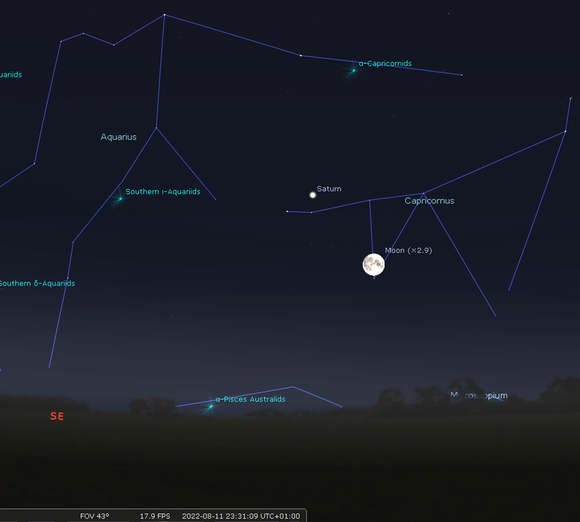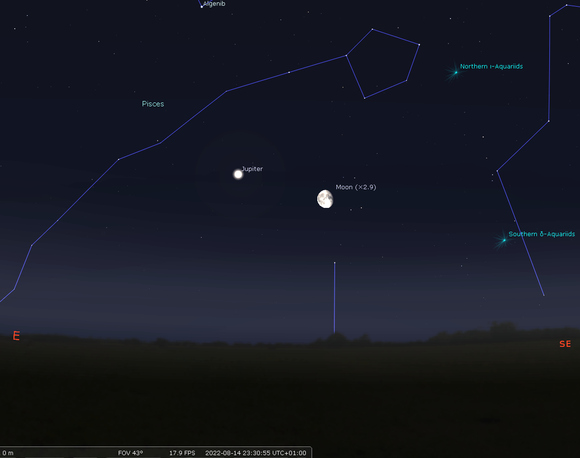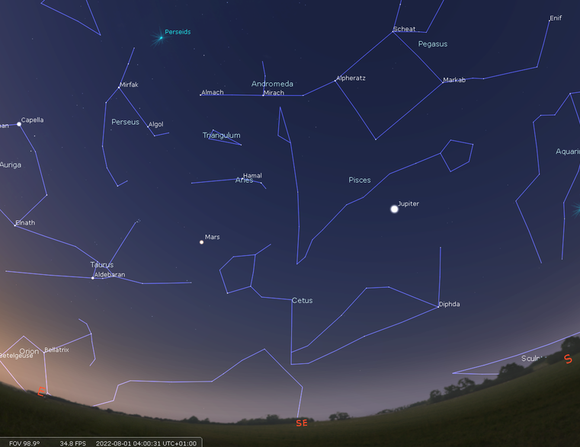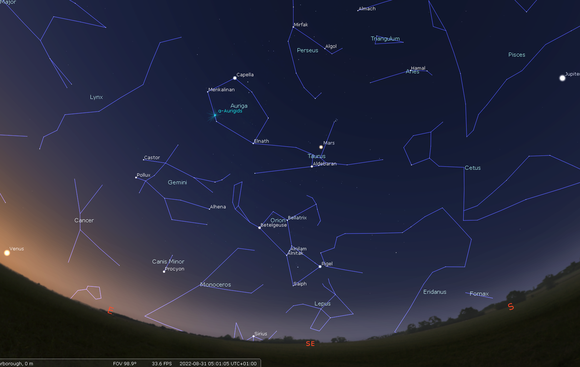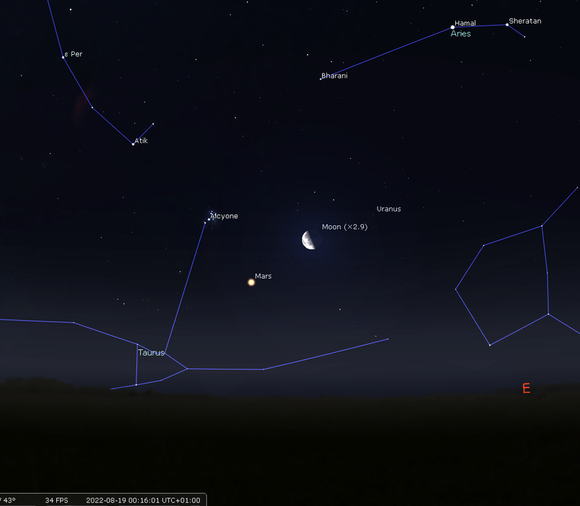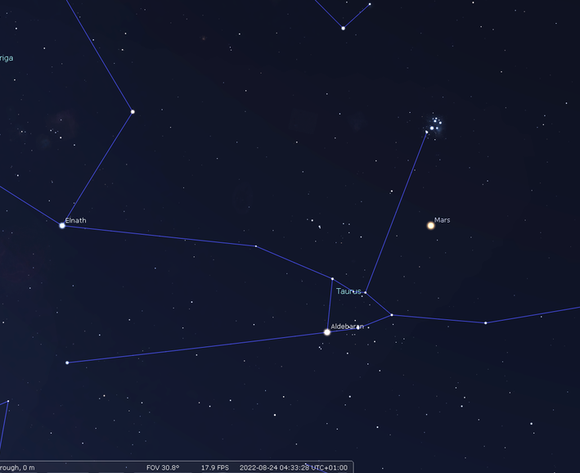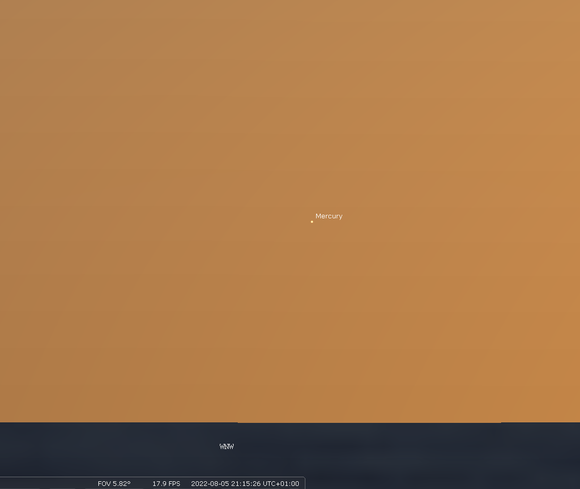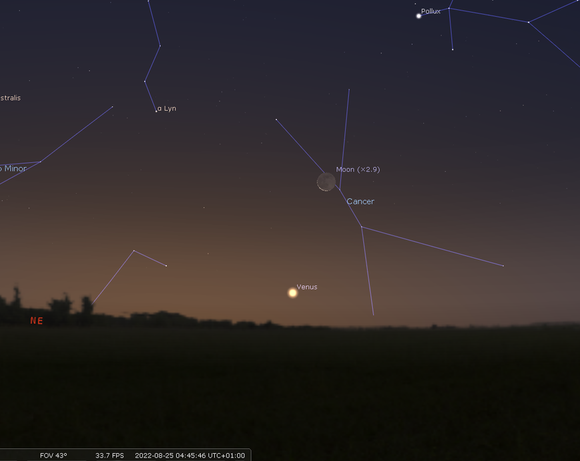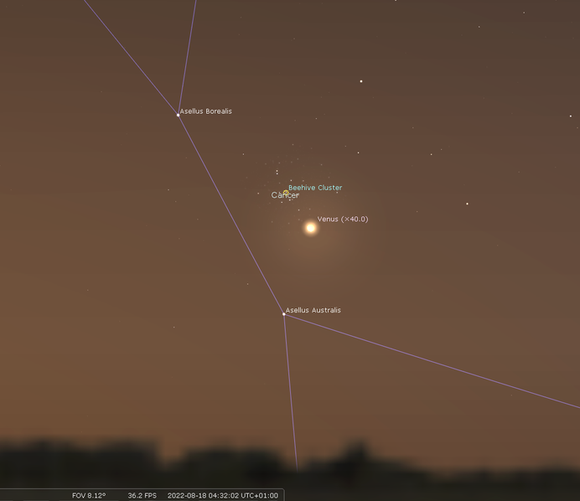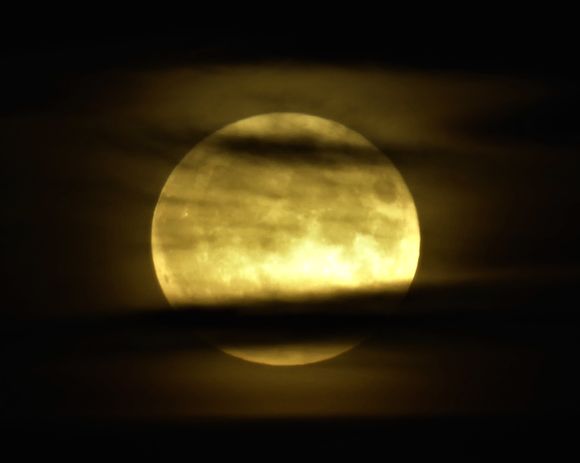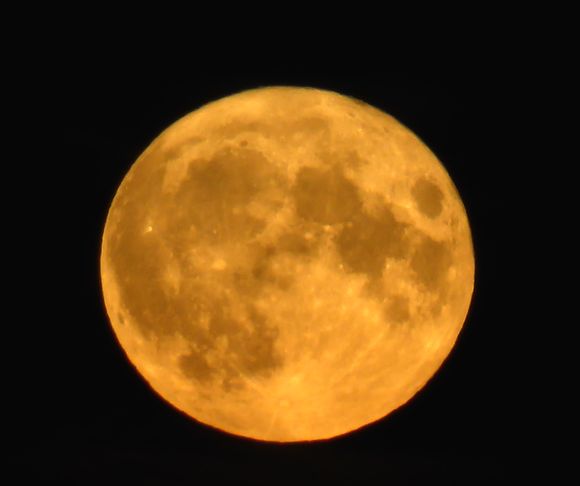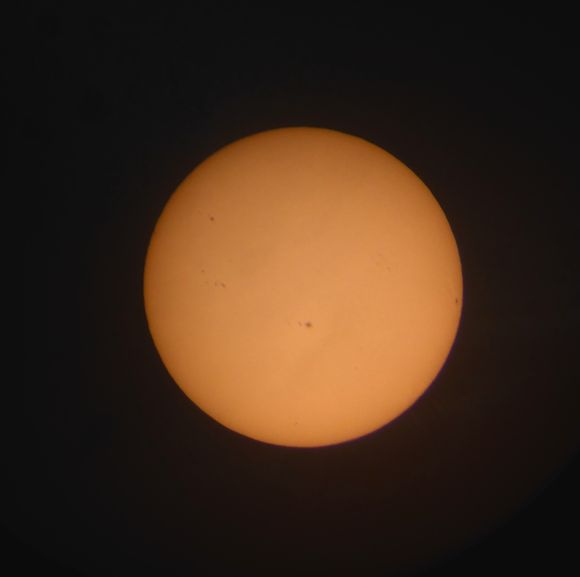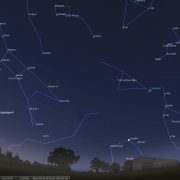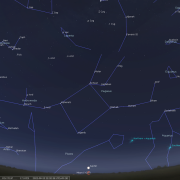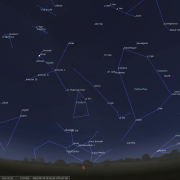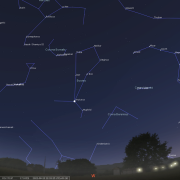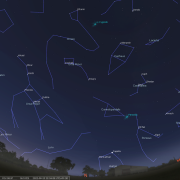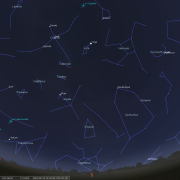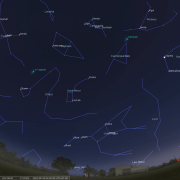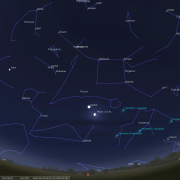In this month's Sky Notes:
- Planetary Skylights.
- August Meteors.
- Noctilucent Cloud - Supermoon & Sunspots.
- August Night Sky.
- August 2022 Sky Charts.
Planetary Skylights - Brief
Saturn comes to opposition this month; Jupiter edges further into the late evening sky, whilst Mars is chiefly an overnight object, although does rise pre-midnight later in the month. Mercury is an extremely difficult spot for northern hemisphere observers in the evening sky. Venus remains the only true pre-dawn planet.
 Saturn reaches opposition on Aug 14th and will be visible all night rising around 22:30hrs. With an apparent magnitude of +0.3 Saturn is pretty conspicuous amongst the stars of Capricornus. Through the eyepiece Saturn appears almost 19 arc seconds in diameter with the rings spanning 42 arc seconds. The rings are of course a wonderful spectacle and remain favourably orientated with respect to Earth, the North Pole tilted toward us by almost 14 degrees.
Saturn reaches opposition on Aug 14th and will be visible all night rising around 22:30hrs. With an apparent magnitude of +0.3 Saturn is pretty conspicuous amongst the stars of Capricornus. Through the eyepiece Saturn appears almost 19 arc seconds in diameter with the rings spanning 42 arc seconds. The rings are of course a wonderful spectacle and remain favourably orientated with respect to Earth, the North Pole tilted toward us by almost 14 degrees.
Culminating over 20 degrees above the S horizon from mid northern latitudes, the chances of better 'seeing' through the eyepiece are increasing. A scope with an aperture of 80-100mm (3.5 - 4") will reveal the two brightest rings; ring A (the outermost) and ring B. These are separated by the Cassini Division. Ring C lies closest to the disk, but more difficult to spot. Saturn has at least 60 moons most of which are beyond the range of amateur scopes. Titan; the largest moon, is noticeable as a speck nearby and at mag +8.4 is bright enough to be spied in small scopes and large binoculars. Titan takes just under 16 days to orbit round Saturn. Scopes of 200mm + (8") will also reveal Rhea, Tethys and Dione as well as Iapetus. The Moon lies below Saturn on Aug 11th.
 Trailing Saturn by approximately an hour, Jupiter starts to make headway into the late evening sky moving in retrograde motion (from east to west) until September. Look for a conspicuous beacon low to east by 23:00hrs at the start of the month and by 21:00hrs at the end. At magnitude -2.7 Jupiter should be obvious to the naked eye below the faint stars of Pisces and appears a whopping 45 arc seconds in diameter through the eyepiece. As Jupiter moves into Pisces it is starting to gain in elevation and from the UK attains a very respectable 40 degrees plus in altitude above the S horizon in the pre-dawn sky, well clear of the most turbulent air lower down. As a consequence 'seeing' will be much improved and detail in the eyepiece better resolved.
Trailing Saturn by approximately an hour, Jupiter starts to make headway into the late evening sky moving in retrograde motion (from east to west) until September. Look for a conspicuous beacon low to east by 23:00hrs at the start of the month and by 21:00hrs at the end. At magnitude -2.7 Jupiter should be obvious to the naked eye below the faint stars of Pisces and appears a whopping 45 arc seconds in diameter through the eyepiece. As Jupiter moves into Pisces it is starting to gain in elevation and from the UK attains a very respectable 40 degrees plus in altitude above the S horizon in the pre-dawn sky, well clear of the most turbulent air lower down. As a consequence 'seeing' will be much improved and detail in the eyepiece better resolved.
Jupiter is always fascinating to study through a telescope, noting any changes to the banding across the disk, or to the GRS (Great Red Spot) as well as following the dance of the Galilean moon's and observing associated transits and shadow transits. The Great Red Spot (GRS), a colossal storm system, is visible to instruments of 80mm and above and over the last few decades seems to have diminished in size and hue intensity, so is of great interest to astronomers who monitor its size and shape.
Jupiter possesses the four Galilean moons (Io, Europa, Ganymede and Callisto), planetary sized worlds which orbit around their parent planet. All are of huge scientific interest to professional astronomers, but for amateurs it is the ever changing configuration, transits, shadow transits and occultation’s that are the draw. From next month the most favourable events will be highlighted once again. A waning gibbous Moon lies immediately right of Jupiter on Aug 14th.
 Mars also finally re-emerges into the pre-midnight sky, although the red planet won't be noticeable until late in the month. As regards observations it should still be considered as an overnight/pre-dawn object. The red planet does not reach opposition until December, but is slowly brightening and by the end of August will be readily conspicuous at magnitude - 0.1. Residing in Taurus, Mars is improving on the ecliptic for UK observers, appearing higher in the sky, initially over 40 degrees above the SE horizon by dawn and 50 degrees by the month's end allowing an observing window of over 4 hours. Mars passes 5 degrees below the Pleiades star cluster overnight Aug 23/24th, with the Moon nearest on the 19th.
Mars also finally re-emerges into the pre-midnight sky, although the red planet won't be noticeable until late in the month. As regards observations it should still be considered as an overnight/pre-dawn object. The red planet does not reach opposition until December, but is slowly brightening and by the end of August will be readily conspicuous at magnitude - 0.1. Residing in Taurus, Mars is improving on the ecliptic for UK observers, appearing higher in the sky, initially over 40 degrees above the SE horizon by dawn and 50 degrees by the month's end allowing an observing window of over 4 hours. Mars passes 5 degrees below the Pleiades star cluster overnight Aug 23/24th, with the Moon nearest on the 19th.
Through the eyepiece Mars remains a small disk (actually 84% gibbous), but is increasing to almost 10 arc seconds by the month’s end. Some very subtle markings may be noticeable in larger instruments, but it’s a couple of months before observations really start to become interesting for the vast majority of amateur astronomers.
 Mercury has an extremely challenging evening apparition for UK observers early in August. The best chance of spotting it will be until Aug 5th viewing at 21:15hrs a few degrees above the WNW horizon.
Mercury has an extremely challenging evening apparition for UK observers early in August. The best chance of spotting it will be until Aug 5th viewing at 21:15hrs a few degrees above the WNW horizon.
 Venus continues its role as the only genuine pre-dawn planet, residing low to the NE horizon. Outshining even Jupiter, Venus at magnitude - 3.9 is by far the brightest planet visible in the dawn sky. The 'morning star' is however sliding ever lower and will require an unobstructed NE horizon in which to locate it. View on the morning of August 18th @ 04:30 when Venus lies just 0.9 degrees south of the star cluster M44 or the Beehive in Cancer. Through the eyepiece, Venus exhibits a growing gibbous phase, but little else will be discerned. A very slim waning crescent Moon resides above Venus on August 25th @ 04:45hrs.
Venus continues its role as the only genuine pre-dawn planet, residing low to the NE horizon. Outshining even Jupiter, Venus at magnitude - 3.9 is by far the brightest planet visible in the dawn sky. The 'morning star' is however sliding ever lower and will require an unobstructed NE horizon in which to locate it. View on the morning of August 18th @ 04:30 when Venus lies just 0.9 degrees south of the star cluster M44 or the Beehive in Cancer. Through the eyepiece, Venus exhibits a growing gibbous phase, but little else will be discerned. A very slim waning crescent Moon resides above Venus on August 25th @ 04:45hrs.
Meteor Activity - August - Perseids
Meteor activity is rather low during summer, with one exception; the Perseids, one of the more reliable meteor showers and perhaps the one meteor shower people make some effort to view. The Perseids are composed of debris deposited over thousands of years by the periodic comet Swift Tuttle. It is various strands of this debris which Earth encounters each August, giving rise to the eagerly anticipated shooting stars. The Perseids are active from late July until after mid August, normally reaching a peak overnight Aug 12-13th. Unfortunately for the 2022 show, moonlight from an almost full Moon rising around 21:30hrs on the 12th will severely hamper observations, drowning out many Perseids.
It is widely perceived amongst the public that meteors are quite substantial in size, but are in fact typically coffee granule in size. These meteoroids penetrate the upper atmosphere 60 miles above our heads at speeds of 43miles/second, before becoming ionised and releasing a packet of light. It is this brief luminous flash we call a meteor. The radiant of the Perseid shower: the location in the sky from which the meteors appear to emanate, lies within the constellation of Perseus, which in August is rising in the north east during the evening. Under ideal conditions the zenith hourly rate (ZHR) for the Perseids is typically 80-100, but as mentioned earlier conditions will be far from ideal and rates will be less than a quarter of this, just the brightest - perhaps a dozen per hour post midnight. Always worth a peek though – especially if skies are clear!
Noctilucent Cloud- Supermoon and Sunspots
Still have not managed to image a display of Noctilucent cloud this summer, bad luck, bad timing, and as of late July bad weather have all played their part in failing to capture those displays that have been witnessed by others. There is still time (just) so keep persevering - as i will and you never know. On the other hand the super moon of July 13th was imaged by Mark rising above the town. It was later than assumed, and very low, in fact many people may have missed it altogether.
The supermoon of July 13th - 23:00hrs rising out of a cloud bank on the horizon
(click for full image) image by Mark D
From the Moon to the Sun; this for much of July was beating down breaking all kinds of temperature records in the UK. Taking a closer look at our fiery neighbour (using a safely filtered telescope) Mark was able to capture a decent sunspot collection on July 17th. The scope employed was a Helios 100mm F 5 refractor with an Orion glass solar filter. Hand held Lumix TZ70 camera - butt-up to eyepiece - amazing what results you can achieve for very little money!
August Night Sky
With the resumption of true astronomical twilight in August as evening begin to draw back in, skies are fully dark once again by midnight. The brightest stars emerge shortly before 21:00hrs led by Arcturus in the west and Vega overhead, followed by Deneb (high to the east) and Altair (midway up in the south) and completing this initial clutch of stellar luminaries, Capella low to the north. By 22:30hrs the majority of the fainter stars visible to the naked eye complete the celestial jigsaw puzzle, making constellation recognition that much easier. You will then find the familiar saucepan outline of the ‘Plough’ (part of Ursa Major, the Great Bear) high in the NW, the arc of its handle pointing down in the direction of brilliant star Arcturus in Bootes the Herdsman. Note the delicate starry circlet of Corona Borealis - the Northern Crown, situated to the upper left of Arcturus. Its chief star Alphecca acts as the centre stone on this tiara.
Much of the SW aspect of the summer evening sky is occupied by just two constellations. The figure of Hercules sprawls across the higher regions of the SW, a little above Corona and is best identified by the ‘keystone’ asterism. Below Hercules extending down toward the WSW horizon, the huge, but rather indistinct outline of Ophuichus, the serpent bearer stands. As dusk falls in this direction you may just spy the orange hue of Antares in Scorpius just above the horizon. Due south the visible portion of Sagittarius as seen from the UK; the large asterism known as the ‘Teapot’, can be traced if skies are transparent. It resembles a teapot slightly tipped up as though pouring a 'cuppa'.
Yet more zodiac constellations occupy the sky above the SE and E horizons. These include Capricornus - the Sea Goat (SSE), Aquarius- the Water Bearer (ESE) and Pisces - the Fish (E). None are particularly easy to trace from light polluted skies or if strong moonlight is present. Pick a dark site to view the stars in these groups.
Rivalling Arcturus in brilliance, steely blue Vega in the small lozenge shaped pattern of Lyra rides high overhead. Along with Deneb and Altair, it makes up the ‘summer triangle’. Look for the two small but distinctive patterns of Sagitta and Delphinius adjacent to the Deneb/Altair side of the triangle. Sagitta is comprised of just 5 stars and according to one legend is associated with Cupid’s arrow. The close-knit group of Delphinus does (with a little imagination) resemble the outline of a dolphin leaping out of water. Bizarrely the group is also known as ‘Jobs coffin’.
Facing North, look for the pole star Polaris, in Ursa Minor. It may be located by using the pointer stars in the ‘bowl’ of the Plough. The zenith is occupied by the head of Draco, the body of which winds between the two bears. Climbing away from the NNE horizon the great hero Perseus strikes a pose, whilst the familiar “W” pattern of Queen Cassiopeia holds court above his right shoulder. Her daughter, the princess Andromeda is located lower right, marked by a chain of stars extending towards the winged horse Pegasus which occupies the mid regions of the East sky. It is within the borders of Andromeda that our “sister” galaxy can be glimpsed on clear moonless nights, the most remote object visible to the naked eye - a staggering 2.65 million light years away! The sight of the great square of Pegasus reminds astronomers that a change of season is in the offing
.
August 2022 Sky Charts
Additional Image Credits:
- Planets and Comets where not otherwise mentioned: NASA
- Sky Charts: Stellarium Software and Starry Night Pro Plus 8
- Log in to post comments

